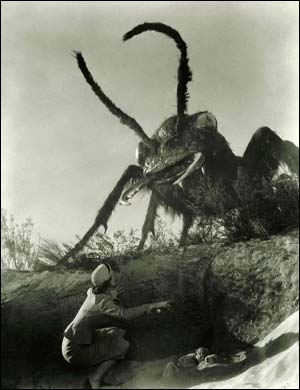Biology Visualization and Monster Biology
Cell Visualizations
Harvard University commisioned this company to develop computer generated movies of the molecular cell processes, there is a 3 minute trailer available here. It looks really really awesome, I wonder if they will eventually make it availble to buy? I would be really interested to see this kind of thing in action as I'm a very visual person.
 B-Movie Biology
B-Movie BiologyAnd here is an article that analyzes the bad biology behind many of the B-movies of the past century. From King Kong, to shrunken protagonists and then to giant ants, its an interesting read, here's a sample:
These super-ants have several problems, although neither they nor the humans seem to appreciate it. First, let's start with the vulnerability of an insect the size of a small elephant. The giant insects don't look terribly vulnerable--small arms and machine guns don't seem to have much effect on them. Part of this relative invulnerability is certainly due to the fact that arthropods wear their skeleton on the outside, where it can act as armor, but I'd argue that the military is using the wrong weapons and aiming at the wrong targets.
Insects have a much more distributed nervous system than vertebrates, so the head is a pretty poor target. So is the body. Because of their highly efficient respiratory system (see Mothra, in Session 4), circulatory demands are much lower in insects than in vertebrates; they can get away with a fairly low-pressure circulatory system. A hole in the exoskeleton, even a 30-caliber hole, just isn't going to bleed much, and the hole will be quickly sealed because insect blood has excellent clotting characteristics. The heart is on the dorsal side of the body, so it, too, makes a lousy target.
So where are they vulnerable? The secret lies in the exoskeleton. Hollow tubes are mechanically very efficient structures, especially for resisting bending--the nastiest way you can load a structure. (Don't believe me? Take a toothpick and break it. Easy, wasn't it? But you broke it by bending it, so take another toothpick, grab one end in each hand, and pull straight along the length of the toothpick. Pretty tough in pure tension, isn't it? Now take another toothpick and grab it between the thumb and first fingers of each hand, with your thumbs a half inch or less apart, and try to break the toothpick by pushing along the length of the toothpick. Pretty tough in compression, too.)

0 Comments:
Post a Comment
<< Home